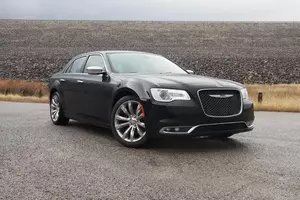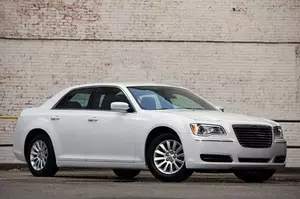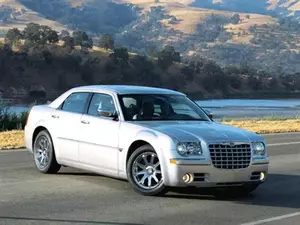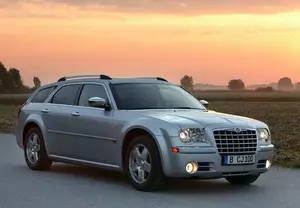
| Vehicle | Curb weight | Difference from world's smallest | Weight to power ratio | 0—60 mph acceleration ratio | Consumption ratio |
|---|---|---|---|---|---|
| SRT 6.4 |
1946 kg / 4291 lbs |
1521 kg (3354 lbs) heavier | 4 kg to 1 hp | - |
150 kg/L (331 lbs/L) |
| 3.6 |
1828 kg / 4031 lbs |
1403 kg (3094 lbs) heavier | 6 kg to 1 hp | - | - |
| 5.7 |
1962 kg / 4326 lbs |
1537 kg (3389 lbs) heavier | 5 kg to 1 hp | - | - |
| S 3.6 |
1828 kg / 4031 lbs |
1403 kg (3094 lbs) heavier | 6 kg to 1 hp | - | - |
| Vehicle | SRT 6.4 |
|---|---|
| Curb weight |
1946 kg / 4291 lbs |
| Difference from world's smallest | 1521 kg (1521 lbs) heavier |
| Weight to power ratio | 4 kg to 1 hp |
| 0—60 mph acceleration ratio | - |
| Consumption ratio |
150 kg/L (331 lbs/L) |
| Vehicle | 3.6 |
| Curb weight |
1828 kg / 4031 lbs |
| Difference from world's smallest | 1403 kg (1403 lbs) heavier |
| Weight to power ratio | 6 kg to 1 hp |
| 0—60 mph acceleration ratio | - |
| Consumption ratio | - |
| Vehicle | 5.7 |
| Curb weight |
1962 kg / 4326 lbs |
| Difference from world's smallest | 1537 kg (1537 lbs) heavier |
| Weight to power ratio | 5 kg to 1 hp |
| 0—60 mph acceleration ratio | - |
| Consumption ratio | - |
| Vehicle | S 3.6 |
| Curb weight |
1828 kg / 4031 lbs |
| Difference from world's smallest | 1403 kg (1403 lbs) heavier |
| Weight to power ratio | 6 kg to 1 hp |
| 0—60 mph acceleration ratio | - |
| Consumption ratio | - |

| Vehicle | Curb weight | Difference from world's smallest | Weight to power ratio | 0—60 mph acceleration ratio | Consumption ratio |
|---|---|---|---|---|---|
| 3.6 |
1828 kg / 4031 lbs |
1403 kg (3094 lbs) heavier | 6 kg to 1 hp | 273 kg/s (602 lbs/s) |
188 kg/L (415 lbs/L) |
| 5.7 |
1937 kg / 4271 lbs |
1512 kg (3334 lbs) heavier | 5 kg to 1 hp | 380 kg/s (838 lbs/s) | - |
| SRT8 6.4 HEMI V8 |
1980 kg / 4366 lbs |
1555 kg (3429 lbs) heavier | 4 kg to 1 hp | - | - |
| Vehicle | 3.6 |
|---|---|
| Curb weight |
1828 kg / 4031 lbs |
| Difference from world's smallest | 1403 kg (1403 lbs) heavier |
| Weight to power ratio | 6 kg to 1 hp |
| 0—60 mph acceleration ratio | 273 kg/s (602 lbs/s) |
| Consumption ratio |
188 kg/L (415 lbs/L) |
| Vehicle | 5.7 |
| Curb weight |
1937 kg / 4271 lbs |
| Difference from world's smallest | 1512 kg (1512 lbs) heavier |
| Weight to power ratio | 5 kg to 1 hp |
| 0—60 mph acceleration ratio | 380 kg/s (838 lbs/s) |
| Consumption ratio | - |
| Vehicle | SRT8 6.4 HEMI V8 |
| Curb weight |
1980 kg / 4366 lbs |
| Difference from world's smallest | 1555 kg (1555 lbs) heavier |
| Weight to power ratio | 4 kg to 1 hp |
| 0—60 mph acceleration ratio | - |
| Consumption ratio | - |

| Vehicle | Curb weight | Difference from world's smallest | Weight to power ratio | 0—60 mph acceleration ratio | Consumption ratio |
|---|---|---|---|---|---|
| LWB 3.5 V6 |
1756 kg / 3872 lbs |
1331 kg (2935 lbs) heavier | 7 kg to 1 hp | - | - |
| 3.5 V6 |
1729 kg / 3812 lbs |
1304 kg (2875 lbs) heavier | 7 kg to 1 hp | 199 kg/s (439 lbs/s) | - |
| 2.7 V6 |
1693 kg / 3733 lbs |
1268 kg (2796 lbs) heavier | 9 kg to 1 hp | 161 kg/s (355 lbs/s) | - |
| 3.0 24V CRD |
1840 kg / 4057 lbs |
1415 kg (3120 lbs) heavier | 8 kg to 1 hp | 256 kg/s (564 lbs/s) | - |
| 6.1 i V8 16V SRT-8 |
1888 kg / 4163 lbs |
1463 kg (3226 lbs) heavier | 4 kg to 1 hp | 393 kg/s (867 lbs/s) |
148 kg/L (326 lbs/L) |
| 5.7 i V8 16V |
1840 kg / 4057 lbs |
1415 kg (3120 lbs) heavier | 5 kg to 1 hp | 307 kg/s (677 lbs/s) |
150 kg/L (331 lbs/L) |
| 5.7 i V8 AWD |
1935 kg / 4267 lbs |
1510 kg (3330 lbs) heavier | 6 kg to 1 hp | - | - |
| Vehicle | LWB 3.5 V6 |
|---|---|
| Curb weight |
1756 kg / 3872 lbs |
| Difference from world's smallest | 1331 kg (1331 lbs) heavier |
| Weight to power ratio | 7 kg to 1 hp |
| 0—60 mph acceleration ratio | - |
| Consumption ratio | - |
| Vehicle | 3.5 V6 |
| Curb weight |
1729 kg / 3812 lbs |
| Difference from world's smallest | 1304 kg (1304 lbs) heavier |
| Weight to power ratio | 7 kg to 1 hp |
| 0—60 mph acceleration ratio | 199 kg/s (439 lbs/s) |
| Consumption ratio | - |
| Vehicle | 2.7 V6 |
| Curb weight |
1693 kg / 3733 lbs |
| Difference from world's smallest | 1268 kg (1268 lbs) heavier |
| Weight to power ratio | 9 kg to 1 hp |
| 0—60 mph acceleration ratio | 161 kg/s (355 lbs/s) |
| Consumption ratio | - |
| Vehicle | 3.0 24V CRD |
| Curb weight |
1840 kg / 4057 lbs |
| Difference from world's smallest | 1415 kg (1415 lbs) heavier |
| Weight to power ratio | 8 kg to 1 hp |
| 0—60 mph acceleration ratio | 256 kg/s (564 lbs/s) |
| Consumption ratio | - |
| Vehicle | 6.1 i V8 16V SRT-8 |
| Curb weight |
1888 kg / 4163 lbs |
| Difference from world's smallest | 1463 kg (1463 lbs) heavier |
| Weight to power ratio | 4 kg to 1 hp |
| 0—60 mph acceleration ratio | 393 kg/s (867 lbs/s) |
| Consumption ratio |
148 kg/L (326 lbs/L) |
| Vehicle | 5.7 i V8 16V |
| Curb weight |
1840 kg / 4057 lbs |
| Difference from world's smallest | 1415 kg (1415 lbs) heavier |
| Weight to power ratio | 5 kg to 1 hp |
| 0—60 mph acceleration ratio | 307 kg/s (677 lbs/s) |
| Consumption ratio |
150 kg/L (331 lbs/L) |
| Vehicle | 5.7 i V8 AWD |
| Curb weight |
1935 kg / 4267 lbs |
| Difference from world's smallest | 1510 kg (1510 lbs) heavier |
| Weight to power ratio | 6 kg to 1 hp |
| 0—60 mph acceleration ratio | - |
| Consumption ratio | - |

| Vehicle | Curb weight | Difference from world's smallest | Weight to power ratio | 0—60 mph acceleration ratio | Consumption ratio |
|---|---|---|---|---|---|
| 3.5 i V6 24V |
1746 kg / 3850 lbs |
1321 kg (2913 lbs) heavier | 7 kg to 1 hp | 201 kg/s (443 lbs/s) |
155 kg/L (342 lbs/L) |
| 2.7 i V6 24V |
1725 kg / 3804 lbs |
1300 kg (2867 lbs) heavier | 9 kg to 1 hp | 164 kg/s (362 lbs/s) |
154 kg/L (340 lbs/L) |
| 3.0 24V CRD |
1875 kg / 4134 lbs |
1450 kg (3197 lbs) heavier | 9 kg to 1 hp | 250 kg/s (551 lbs/s) | - |
| 3.5 i V6 24V AWD |
1902 kg / 4194 lbs |
1477 kg (3257 lbs) heavier | 8 kg to 1 hp | 219 kg/s (483 lbs/s) |
160 kg/L (353 lbs/L) |
| 5.7 i V8 16V |
1860 kg / 4101 lbs |
1435 kg (3164 lbs) heavier | 5 kg to 1 hp | 305 kg/s (673 lbs/s) |
149 kg/L (329 lbs/L) |
| 5.7 i V8 AWD |
1969 kg / 4342 lbs |
1544 kg (3405 lbs) heavier | 6 kg to 1 hp | 323 kg/s (712 lbs/s) |
149 kg/L (329 lbs/L) |
| 6.1 i V8 16V SRT-8 |
1965 kg / 4333 lbs |
1540 kg (3396 lbs) heavier | 5 kg to 1 hp | 409 kg/s (902 lbs/s) | - |
| Vehicle | 3.5 i V6 24V |
|---|---|
| Curb weight |
1746 kg / 3850 lbs |
| Difference from world's smallest | 1321 kg (1321 lbs) heavier |
| Weight to power ratio | 7 kg to 1 hp |
| 0—60 mph acceleration ratio | 201 kg/s (443 lbs/s) |
| Consumption ratio |
155 kg/L (342 lbs/L) |
| Vehicle | 2.7 i V6 24V |
| Curb weight |
1725 kg / 3804 lbs |
| Difference from world's smallest | 1300 kg (1300 lbs) heavier |
| Weight to power ratio | 9 kg to 1 hp |
| 0—60 mph acceleration ratio | 164 kg/s (362 lbs/s) |
| Consumption ratio |
154 kg/L (340 lbs/L) |
| Vehicle | 3.0 24V CRD |
| Curb weight |
1875 kg / 4134 lbs |
| Difference from world's smallest | 1450 kg (1450 lbs) heavier |
| Weight to power ratio | 9 kg to 1 hp |
| 0—60 mph acceleration ratio | 250 kg/s (551 lbs/s) |
| Consumption ratio | - |
| Vehicle | 3.5 i V6 24V AWD |
| Curb weight |
1902 kg / 4194 lbs |
| Difference from world's smallest | 1477 kg (1477 lbs) heavier |
| Weight to power ratio | 8 kg to 1 hp |
| 0—60 mph acceleration ratio | 219 kg/s (483 lbs/s) |
| Consumption ratio |
160 kg/L (353 lbs/L) |
| Vehicle | 5.7 i V8 16V |
| Curb weight |
1860 kg / 4101 lbs |
| Difference from world's smallest | 1435 kg (1435 lbs) heavier |
| Weight to power ratio | 5 kg to 1 hp |
| 0—60 mph acceleration ratio | 305 kg/s (673 lbs/s) |
| Consumption ratio |
149 kg/L (329 lbs/L) |
| Vehicle | 5.7 i V8 AWD |
| Curb weight |
1969 kg / 4342 lbs |
| Difference from world's smallest | 1544 kg (1544 lbs) heavier |
| Weight to power ratio | 6 kg to 1 hp |
| 0—60 mph acceleration ratio | 323 kg/s (712 lbs/s) |
| Consumption ratio |
149 kg/L (329 lbs/L) |
| Vehicle | 6.1 i V8 16V SRT-8 |
| Curb weight |
1965 kg / 4333 lbs |
| Difference from world's smallest | 1540 kg (1540 lbs) heavier |
| Weight to power ratio | 5 kg to 1 hp |
| 0—60 mph acceleration ratio | 409 kg/s (902 lbs/s) |
| Consumption ratio | - |